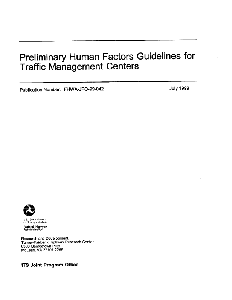Preliminary Human Factors Guidelines for Traffic Management Centers
FOREWORD
Traffic management centers are increasing in number and are receiving significant upgrades to respond to growing congestion in the roadway system. This growth
in traffic management activity entails the installation of more and different types of traffic sensor and control systems. The integration of these systems
leads to greater dependence on automation and intelligent systems to monitor and process large quantities of data, to assist decision making and to control
traffic. In turn, this growing reliance on automation raises human factors issues on how traffic management operators share tasks with automation and what kind
of environment is necessary for their work to be effectively completed.
This document provides human factors guidelines and other information to bear on these issues. For instance, chapters are provided for job design, the user–computer interface, workspace, controls and displays. Sections are also provided on the systems engineering design process. As traffic management centers coordinate with each other to devise new strategies and to meet regional traffic demands, new issues and new perspectives on the role of the human in traffic management will evolve. It is anticipated that these guidelines will form a basis for further examination of future operator requirements and thus continue to support effective user–system design.

Michael F. Trentacoste, Director
Office of Safety Research and Development

PDF Version (21 MB)
PDF files can be viewed with the Acrobat® Reader®
TECHNICAL REPORT DOCUMENTATION PAGE
| 1. Report No. FHWA–JPO–99–042 |
2. Government Accession No. |
3. Recipient's Catalog No. |
| 4. Title and Subtitle Preliminary Human Factors Guidelines for Traffic Management Centers |
5. Report Date July 1999 |
| |
6. Performing Organization Code |
| 7. Author(s) Michael J. Kelly |
8. Performing Organization Report No. |
| 9. Performing Organization Name and Address
Electronic Systems Laboratory
Georgia Tech Research Institute
Georgia Institute of Technology
Atlanta, Georgia 30332–0840
|
10. Work Unit No. (TRAIS) |
| |
11. Contract or Grant No. DTFH61–92–C–00094 |
| 12. Sponsoring Agency Name and Address
Federal Highway Administration
6300 Georgetown Pike, T–304
McLean, Virginia 22101–2296
|
13. Type of Report and Period Covered |
| |
14. Sponsoring Agency Code |
| 15. Supplementary Notes COTR: Nazemeh Sobhi, HRDS; with assistance from SAIC |
| 16. Abstract
This document provides human factors guidance for designers, owners, operators, and planners engaged in the development and operation of
traffic management centers. Specific guidance addresses several dimensions of the work environment that can affect operator and system performance.
These dimensions include the operator's work space, the equipment that operators use, and the design of their jobs. Additional guidance is
provided for the user–centered design process. Supporting this guidance are several sections on operator capabilities. Several chapters address
equipment design and selection. These include the user–computer interface, controls, displays, and job aids. The chapter on job design addresses
shift work, team work, simultaneous tasks and workload, and the role of operators designing jobs.
This document is intended for application in planning new TMC's and for planning modifications to existing TMC's. In addition to guidance
in the design of new equipment, workstations, and software, the document supports planned modification of equipment and the selection of
off–the–shelf equipment. The guidelines also support specification development. At the beginning of this project, there was little human
factors research specific to traffic management centers. Therefore, much of the guidance contained herein is composed of human factors material from
non–TMC specific sources that are, nonetheless, relevant to traffic management centers. Recent research from this project has been incorporated into
the guidelines. TMC specific guidelines cover areas such as incident detection and the management of variable message signs. An earlier version
of this document was released under the title: "Human Factors Handbook for Advanced Traffic Management System Design."
|
| 17. Key Words
Advanced Traffic Management Systems, Equipment Design, Human Factors, Intelligent Transportation Systems (ITS), Job Design, Traffic Management
Center, Work Space Design
|
18. Distribution Statement
No restrictions. This document is available to the public through the National Technical Information Service, Springfield, VA 22161.
|
| 19. Security Classif. (of this report) Unclassified |
20. Security Classif. (of this page) Unclassified |
21. No. of Pages 480 |
22. Price N/A |
Form DOT F 1700.7 (8–72) Reproduction of completed page authorized
FHWA–JPO–99–042
|
